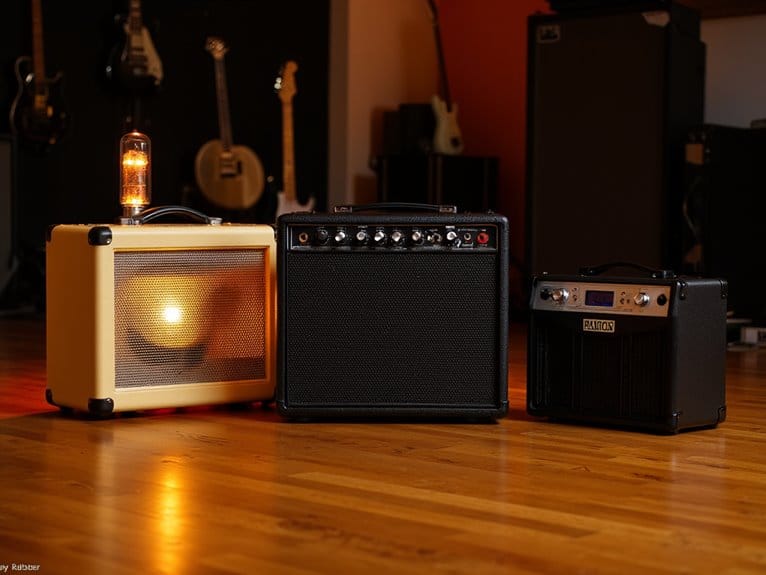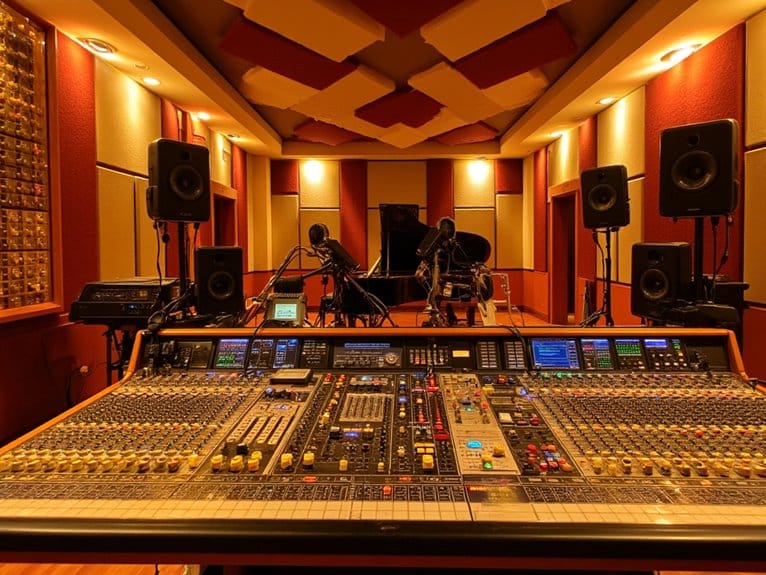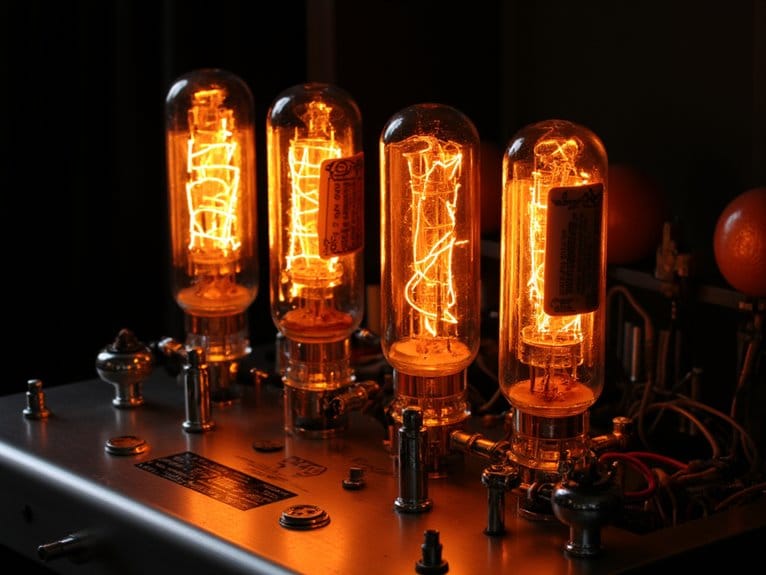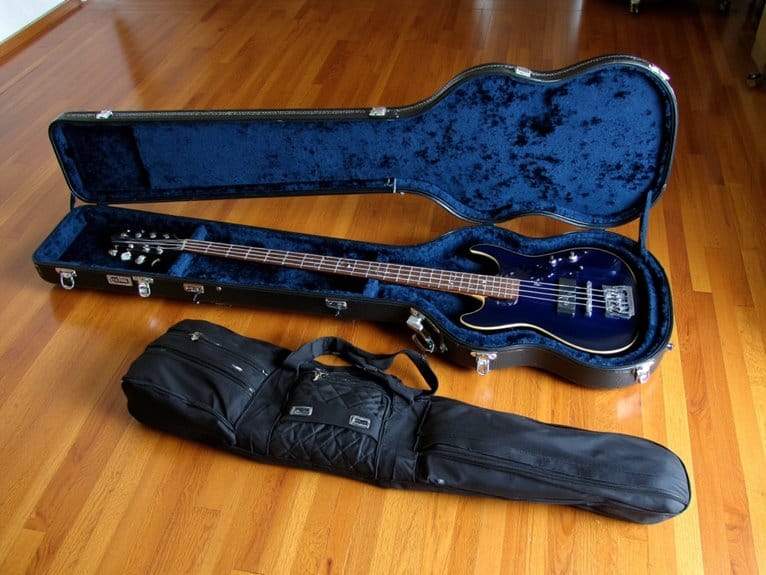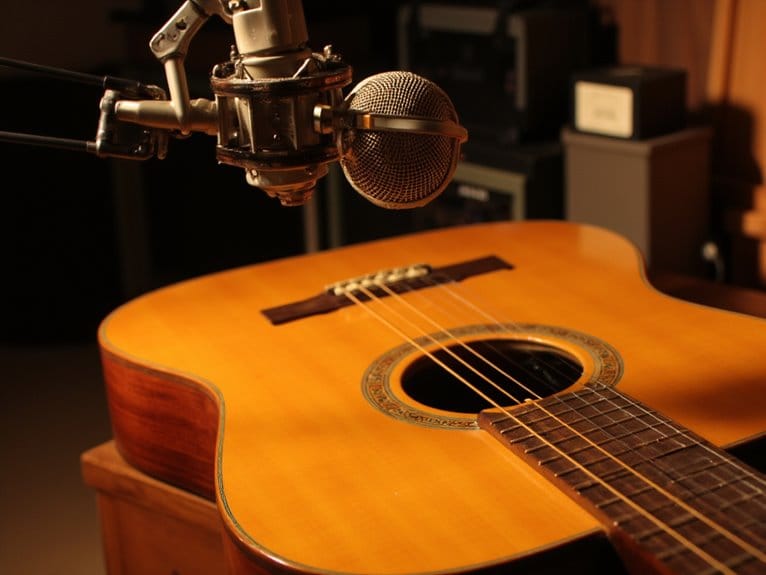Tube Vs Solid-State Vs Modeling Guitar Amps: Which Is Right for You?
You’ll choose between tube amps for their warm, dynamic tone and natural harmonic sweetness ($400+), solid-state amps for reliable, consistent amplification with minimal maintenance (under $300), or modeling amps for versatile digital recreation of multiple amp sounds with practice-friendly features like headphone outputs ($150+). Tube amps excel in touch sensitivity but require careful handling and tube replacements, while solid-state offers durability and solid-state reliability, and modeling provides beginner-friendly versatility with smartphone integration—though your final decision depends on musical preferences, budget constraints, and whether you prioritize authentic tone over practical convenience.
We are supported by our audience. When you purchase through links on our site, we may earn an affiliate commission, at no extra cost for you. Learn more.
Notable Insights
- Tube amps offer superior tone quality with warm, natural harmonics and dynamic touch sensitivity but require higher maintenance and cost.
- Solid-state amps provide reliable, consistent amplification with minimal upkeep and lower costs, ideal for regular gigging and transport.
- Modeling amps deliver versatile tones and effects through digital processing, perfect for beginners wanting multiple sounds affordably.
- Consider your budget: tube amps cost $400-500+, solid-state under $300, and modeling amps start around $150.
- Choose based on priorities: tube for premium tone, solid-state for reliability, modeling for versatility and practice features.
Understanding the Three Main Types of Guitar Amplifiers
Three distinct amplifier technologies dominate the guitar world, and I’ve spent countless hours testing each type to understand how they’ll serve different players and musical situations.
Tube amps use vacuum tubes to control electron flow through glass chambers, creating that warm, dynamic response guitarists have cherished for decades. These amplifiers achieve their authentic warm sound through quality vacuum tubes that provide the rich audio experiences audiophiles seek.
Solid-state amps rely on transistors and semiconductor devices, delivering consistent, reliable amplification without the fragility concerns that come with glass tubes. These amplifiers provide power efficiency for regular gigging and offer dependable performance across various venue sizes.
Modern sound modeling represents the newest amp technology, using digital signal processing to recreate the characteristics of classic tube and solid-state designs within a single unit. Many guitar amplifiers come with a two-year warranty that protects against manufacturer defects, providing peace of mind for your investment.
Each approach offers distinct advantages, from tube warmth to solid-state dependability to modeling versatility. The choice between amp types is largely driven by personal preference, as each technology serves different musical needs and playing environments.
Tone Quality and Sound Characteristics Breakdown
When you’re comparing guitar amps, the most significant differences you’ll notice stem from how each type handles harmonic content, which directly affects the richness and complexity of your tone.
I’ve found that tube amps generate natural harmonics through vacuum tube saturation, while solid-state amps produce cleaner, more linear harmonics.
Modeling amps digitally recreate these harmonic characteristics with varying degrees of success.
The dynamic response variations between these amp types will dramatically influence how your playing style translates into sound, affecting everything from subtle volume swells to aggressive pick attacks.
Tube amplifiers are particularly renowned for their even-order harmonics, which create the warm, musical distortion that audiophiles and guitarists have cherished for decades.
While tube amps offer this warm response, solid-state amps provide greater reliability and consistency without the maintenance requirements of vacuum tubes.
Harmonic Content Differences
The heartbeat of any amplifier’s character lies in its harmonic content, and I’ve spent countless hours analyzing how different amp technologies shape the frequencies that give each design its distinctive voice.
Tube amps excel at harmonic layering through even-order harmonics, creating that warm, musical sweetness you’ll hear from vintage Marshall stacks, while their natural compression enhances sustain beautifully.
Solid-state amps produce odd-order harmonics with cleaner, more linear responses, though their distortion characteristics can sound clinical without careful circuit design.
Modeling amps digitally recreate both harmonic profiles using DSP algorithms, offering remarkable versatility in blending different tonal characters.
What’s fascinating is how circuit design ultimately determines harmonic output regardless of technology, meaning well-engineered solid-state amps can approach tube warmth through strategic filtering and gain staging.
Dynamic Response Variations
Beyond harmonic content, dynamic response separates amplifier technologies more dramatically than any other characteristic, and I’ve found this aspect determines whether you’ll connect emotionally with your amp or find yourself fighting against it.
Tube amps excel in dynamic responsiveness, where your picking intensity directly controls distortion levels—hit harder for natural breakup, play softer for pristine cleans. This touch sensitivity creates an organic conversation between you and your instrument that’s genuinely addictive once experienced.
Solid-state amps deliver consistent, linear amplification regardless of playing dynamics, which works perfectly for styles requiring unwavering clarity but lacks that responsive feel many players crave. Modern solid-state options like the Frontman 10G include overdrive switching that allows seamless transitions between clean and distorted sounds without requiring separate pedals.
For players seeking tube dynamics at manageable volumes, 5-watt tube amps offer authentic tube saturation and natural overdrive without overwhelming volume levels.
- Tube amps compress and distort naturally with increased playing intensity
- Solid-state amps maintain consistent tone across all dynamic ranges
- Modeling amps simulate tube dynamics with varying degrees of authenticity
Durability, Maintenance, and Reliability Factors
When you’re investing in a guitar amp, understanding how different technologies handle the rigors of regular use becomes essential for making a smart purchase decision.
I’ve watched countless musicians struggle with failed tubes during critical performances, while others have relied on their solid-state amps for decades without major issues. This highlights the significant differences in physical construction, maintenance demands, and overall road worthiness between these amp types.
Your choice between tube, solid-state, and modeling amps will largely depend on whether you prioritize that classic tube tone over the convenience of low-maintenance, durable electronics that can withstand years of transport and heavy gigging.
Tube amplifiers require periodic tube replacement and careful handling due to their fragile nature, while solid-state options deliver consistent performance with minimal upkeep requirements. Solid-state amplifiers also offer advantages in portability, as they typically weigh less than their tube counterparts and can better handle frequent transport between venues.
Physical Construction Differences
While I’ve spent countless hours analyzing amp specifications and sound characteristics, I’ve learned that the physical construction differences between tube, solid-state, and modeling amps often determine which one you’ll actually want to gig with regularly.
The construction materials and component arrangement vary dramatically across these three categories, directly impacting your experience as a player.
Tube amps feature fragile glass vacuum tubes mounted in robust chassis designs, typically using hand-wired connections or high-quality PCBs that allow easier servicing but increase weight considerably.
Solid-state amps rely on semiconductor components housed on compact printed circuit boards, creating lighter builds but potentially sacrificing mechanical durability in budget models.
Modeling amps utilize digital circuitry and microprocessors in streamlined enclosures, offering excellent portability while introducing complex electronics that require specialized repair knowledge.
- Tube amps: Heavy transformers and fragile tubes demand careful handling
- Solid-state amps: Compact PCB designs enable mass production but may crack under stress
- Modeling amps: Digital complexity reduces serviceability despite solid-state durability advantages
Maintenance Requirements Comparison
After years of maintaining different amp types in my home studio and watching countless bandmates deal with equipment failures mid-gig, I’ve discovered that your choice between tube, solid-state, and modeling amps will dramatically affect how much time you’ll spend with a screwdriver instead of a pick.
Tube amp maintenance demands the most attention, requiring periodic power tube replacements that affect your volume and tone, plus careful handling since tubes stay dangerously hot for fifteen minutes after shutdown.
Solid state upkeep proves delightfully minimal, typically needing only occasional fuse changes and basic protection from power surges.
Modeling amp software updates through USB ports become your primary maintenance task, replacing traditional tube swapping with firmware patches that keep your digital tones current and bug-free. Modern digital music equipment with audio interfaces requires attention to specifications like frequency response and crosstalk measurements to maintain optimal performance quality.
Similar to how professional mixing consoles can last 15-25 years with proper maintenance, your amp choice directly impacts long-term reliability and maintenance costs.
Road Worthiness Assessment
Three years of loading amps into vans at 2 AM and watching expensive gear tumble down venue stairs has taught me that road worthiness separates weekend warriors from professional performers, and your amp choice determines whether you’ll spend more time fixing gear or making music.
Solid-state amps dominate road transport scenarios because transistors handle vibration, drops, and temperature swings better than delicate vacuum tubes.
Tube amps require careful handling and protective cases, making them less practical for frequent gigging despite their superior tone.
Modeling amps offer decent durability but suffer from heat sensitivity and potential firmware issues.
Professional musicians understand that durable construction withstands heavy playing and frequent transport, which explains why many touring artists prioritize reliability over absolute tonal perfection.
For musicians seeking the ultimate in portable reliability, battery powered amps eliminate concerns about power availability and reduce dependency on venue electrical systems.
- Tube amps need meticulous transport care due to fragile glass components.
- Solid-state models withstand rough handling and environmental extremes effectively.
- Amp longevity depends heavily on brand quality and protective measures during transport.
Cost Analysis and Budget Considerations
When I first started shopping for guitar amps, I quickly discovered that understanding the financial landscape isn’t just about comparing price tags – it’s about evaluating the total cost of ownership, from that initial purchase through years of maintenance, upgrades, and eventual resale.
Your budget evaluation should consider tube amps’ higher entry costs ($400-$500+) and ongoing tube replacements, while solid-state options offer affordable reliability under $300.
Tube amps demand higher upfront investment and maintenance costs, while solid-state alternatives deliver dependable performance at budget-friendly prices.
Modeling amps provide exceptional cost benefit through built-in versatility starting at $150, potentially eliminating pedal purchases.
I’ve learned that professionals often justify $1000+ investments for premium tone or multi-functionality, while beginners find solid-state or modeling amps economically sensible.
For those just starting out, entry-level practice amps like the Marshall MG10G or Fender Mustang LT25 offer quality sound and essential features around the $30-100 range, making them excellent stepping stones before investing in professional-grade equipment. The Mustang LT25 delivers impressive amp modeling capabilities that recreate tones from legendary brands like Fender, Marshall, and Vox, providing versatility typically found in much more expensive equipment.
Portability and Practical Performance Needs
Beyond the financial considerations I’ve explored, the reality of where and how you’ll actually use your amp shapes every decision more than any spec sheet ever could. Your travel convenience and practice scenarios determine whether you’ll reach for that amp or leave it gathering dust.
Tube amps, despite their tonal superiority, present significant weight distribution challenges and extended setup time due to warm-up requirements. Solid-state amps offer reliable portability with straightforward controls, while modeling amps excel in integration options through Bluetooth connectivity and app-based customization.
Consider these practical factors:
- Usage frequency – Daily practice demands different portability than weekend jamming
- Transport logistics – Stairs, car space, and carrying distance matter more than you’d expect
- Power accessibility – Battery-powered options eliminate venue dependency entirely
For practice-focused players, many modern amps now provide battery life ranging from 3-8 hours, making them ideal for outdoor sessions and venues without reliable power sources. For guitarists prioritizing ultimate portability, many manufacturers now design amplifiers with ergonomic handles and lightweight construction under 50 pounds to enhance transport convenience for gigging musicians.
Choosing the Right Amp for Your Musical Style and Goals
How many times have I watched guitarists fall in love with an amp that sounds incredible in the store, only to discover it doesn’t match their musical aspirations once they get home?
Your sound preferences should drive your decision, not flashy features or sales pitches.
Don’t let marketing gimmicks distract you from what truly matters – finding an amp that serves your musical vision.
If you’re primarily playing blues or classic rock, tube amps deliver that natural breakup and harmonic complexity you’re chasing.
Jazz players benefit from solid-state amps‘ crystal-clear articulation and low noise floor, while metal guitarists often gravitate toward high-gain tube models or specific modeling amp voicings.
Genre adaptability matters most if you’re exploring multiple styles – modeling amps excel here, offering preset tones that eliminate the guesswork and let you experiment across musical boundaries. Modern modeling amps can provide 200+ models through smartphone apps, giving you an entire arsenal of vintage and contemporary amp sounds at your fingertips.
For versatile practice scenarios, look for amps with features like headphone outputs and AUX inputs that allow you to jam along with your favorite tracks while maintaining silent practice capabilities.
Frequently Asked Questions
Can I Use Guitar Amp Modeling Software Instead of a Physical Modeling Amp?
You can absolutely use guitar amp modeling software instead of physical modeling amps. Software advantages include lower costs, space savings, and extensive tone options, while maintaining full guitar compatibility through audio interfaces.
Do Tube Amps Sound Better at Bedroom Practice Volumes or Only Loud?
You’ll find tube amps don’t reach their full tonal characteristics at bedroom volume since tubes need some heat to engage properly. Low-wattage tube amps or attenuators help achieve better tube warmth at quieter levels.
How Often Do Vacuum Tubes Actually Need to Be Replaced in Tube Amps?
You’ll find tube lifespan varies considerably – power tubes typically last 2,500+ hours while preamp tubes can go 10,000+ hours. For maintenance tips, replace based on sound degradation rather than fixed schedules.
On a final note
Your perfect amp choice depends on balancing your musical priorities, budget constraints, and practical needs. If you’re chasing that warm, dynamic tube saturation and don’t mind maintenance costs, go tube. Need versatility and reliability? Solid-state delivers consistent performance. Want endless tonal options in a portable package? Modeling amps offer incredible value. There’s no universally “best” option—just what works for your specific situation, playing style, and long-term goals.

